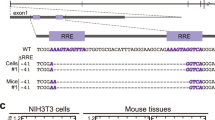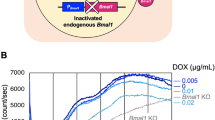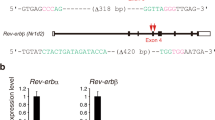Abstract
The PAS (PER-ARNT-SIM) helix-loop-helix transcription factor BMAL1 (also known as MOP3) is an essential component of the circadian pacemaker in mammals. Here we show that the retinoic acid receptor–related orphan receptor RORα (NR1F1) directly activates transcription of Bmal1 through two conserved RORα response elements that are required for cell-autonomous transcriptional oscillation of Bmal1 mRNA. Positive involvement of RORα in generation of the Bmal1 circadian oscillation was verified by behavioral analyses of RORα-deficient staggerer mice that showed aberrant locomotor activity and unstable rhythmicity. In cultured cells, loss of endogenous RORα protein resulted in a dampened circadian rhythm of Bmal1 transcription, further indicating that RORα is a functional component of the cell-autonomous core circadian clock. These results indicate that RORα acts to promote Bmal1 transcription, thereby maintaining a robust circadian rhythm.
This is a preview of subscription content, access via your institution
Access options
Subscribe to this journal
Receive 12 print issues and online access
$189.00 per year
only $15.75 per issue
Buy this article
- Purchase on Springer Link
- Instant access to full article PDF
Prices may be subject to local taxes which are calculated during checkout







Similar content being viewed by others
References
Menaker, M. Circadian rhythms. Circadian photoreception. Science 299, 213–214 (2003).
Balsalobre, A., Damiola, F. & Schibler, U. A serum shock induces circadian gene expression in mammalian tissue culture cells. Cell 93, 929–937 (1998).
Yamazaki, S. et al. Resetting central and peripheral circadian oscillators in transgenic rats. Science 288, 682–685 (2000).
Schibler, U. & Sassone-Corsi, P. A web of circadian pacemakers. Cell 111, 919–922 (2002).
Akashi, M. & Nishida, E. Involvement of the MAP kinase cascade in resetting of the mammalian circadian clock. Genes Dev. 14, 645–649 (2000).
Balsalobre, A., Marcacci, L. & Schibler, U. Multiple signaling pathways elicit circadian gene expression in cultured Rat-1 fibroblasts. Curr. Biol. 10, 1291–1294 (2000).
Glossop, N.R. & Hardin, P.E. Central and peripheral circadian oscillator mechanisms in flies and mammals. J. Cell Sci. 115, 3369–3377 (2002).
Hastings, M.H., Reddy, A.B. & Maywood, E.S. A clockwork web: circadian timing in brain and periphery, in health and disease. Nat. Rev. Neurosci. 4, 649–661 (2003).
Damiola, F. et al. Restricted feeding uncouples circadian oscillators in peripheral tissues from the central pacemaker in the suprachiasmatic nucleus. Genes Dev. 14, 2950–2961 (2000).
Dunlap, J.C. Molecular bases for circadian clocks. Cell 96, 271–290 (1999).
Allada, R., Emery, P., Takahashi, J.S. & Rosbash, M. Stopping time: the genetics of fly and mouse circadian clocks. Annu. Rev. Neurosci. 24, 1091–1119 (2001).
Young, M.W. & Kay, S.A. Time zones: a comparative genetics of circadian clocks. Nat. Rev. Genet. 2, 702–715 (2001).
Reppert, S.M. & Weaver, D.R. Coordination of circadian timing in mammals. Nature 418, 935–941 (2002).
Takumi, T. et al. A light-independent oscillatory gene mPer3 in mouse SCN and OVLT. EMBO J. 17, 4753–4759 (1998).
Gekakis, N. et al. Role of the CLOCK protein in the mammalian circadian mechanism. Science 280, 1564–1569 (1998).
Kume, K. et al. mCRY1 and mCRY2 are essential components of the negative limb of the circadian clock feedback loop. Cell 98, 193–205 (1999).
Panda, S. et al. Coordinated transcription of key pathways in the mouse by the circadian clock. Cell 109, 307–320 (2002).
Storch, K.F. et al. Extensive and divergent circadian gene expression in liver and heart. Nature 417, 78–83 (2002).
Bunger, M.K. et al. Mop3 is an essential component of the master circadian pacemaker in mammals. Cell 103, 1009–1017 (2000).
Shearman, L.P. et al. Interacting molecular loops in the mammalian circadian clock. Science 288, 1013–1019 (2000).
Preitner, N. et al. The orphan nuclear receptor REV-ERBα controls circadian transcription within the positive limb of the mammalian circadian oscillator. Cell 110, 251–260 (2002).
Ueda, H.R. et al. A transcription factor response element for gene expression during circadian night. Nature 418, 534–539 (2002).
Forman, B.M. et al. Cross-talk among ROR α 1 and the Rev-erb family of orphan nuclear receptors. Mol. Endocrinol. 8, 1253–1261 (1994).
Yamamoto, T. et al. Transcriptional oscillation of canonical clock genes in mouse peripheral tissues. BMC Mol. Biol. 5, 18 (2004).
Nakajima, Y. et al. Bidirectional role of orphan nuclear receptor RORα in clock gene transcriptions demonstrated by a novel reporter assay system. FEBS Lett. 565, 122–126 (2004).
Hamilton, B.A. et al. Disruption of the nuclear hormone receptor RORα in staggerer mice. Nature 379, 736–739 (1996).
Chauvet, C., Bois-Joyeux, B. & Danan, J.L. Retinoic acid receptor-related orphan receptor (ROR) α4 is the predominant isoform of the nuclear receptor RORα in the liver and is up-regulated by hypoxia in HepG2 human hepatoma cells. Biochem J. 364, 449–456 (2002).
Dilworth, F.J. & Chambon, P. Nuclear receptors coordinate the activities of chromatin remodeling complexes and coactivators to facilitate initiation of transcription. Oncogene 20, 3047–3054 (2001).
Giguere, V. Orphan nuclear receptors: from gene to function. Endocr. Rev. 20, 689–725 (1999).
Jetten, A.M., Kurebayashi, S. & Ueda, E. The ROR nuclear orphan receptor subfamily: critical regulators of multiple biological processes. Prog. Nucleic Acid Res. Mol. Biol. 69, 205–247 (2001).
Andre, E. et al. Disruption of retinoid-related orphan receptor beta changes circadian behavior, causes retinal degeneration and leads to vacillans phenotype in mice. EMBO J. 17, 3867–3877 (1998).
Sato, T.K. et al. A functional genomics strategy reveals Rora as a component of the mammalian circadian clock. Neuron 43, 527–537 (2004).
Kallen, J.A. et al. X-ray structure of the hRORα LBD at 1.63 Å: structural and functional data that cholesterol or a cholesterol derivative is the natural ligand of RORα. Structure 10, 1697–1707 (2002).
Simons, K. & Ikonen, E. How cells handle cholesterol. Science 290, 1721–1726 (2000).
Balasubramaniam, S., Szanto, A. & Roach, P.D. Circadian rhythm in hepatic low-density-lipoprotein (LDL)-receptor expression and plasma LDL levels. Biochem J. 298, 39–43 (1994).
Wuarin, J. et al. The role of the transcriptional activator protein DBP in circadian liver gene expression. J. Cell Sci. Suppl. 16, 123–127 (1992).
Miki, N., Ikuta, M. & Matsui, T. Hypoxia-induced activation of the retinoic acid receptor-related orphan receptor α4 gene by an interaction between hypoxia-inducible factor-1 and Sp1. J. Biol. Chem. 279, 15025–15031 (2004).
Chauvet, C., Bois-Joyeux, B., Berra, E., Pouyssegur, J. & Danan, J.L. The gene encoding human retinoic acid-receptor-related orphan receptor α is a target for hypoxia-inducible factor 1. Biochem. J. 384, 79–85 (2004).
Bunn, H.F., Gu, J., Huang, L.E., Park, J.W. & Zhu, H. Erythropoietin: a model system for studying oxygen-dependent gene regulation. J. Exp. Biol. 201, 1197–1201 (1998).
Akashi, M., Tsuchiya, Y., Yoshino, T. & Nishida, E. Control of intracellular dynamics of mammalian period proteins by casein kinase I epsilon (CKIε) and CKIδ in cultured cells. Mol. Cell. Biol. 22, 1693–1703 (2002).
Shinagawa, T. & Ishii, S. Generation of Ski-knockdown mice by expressing a long double-strand RNA from an RNA polymerase II promoter. Genes Dev. 17, 1340–1345 (2003).
Shi, Y. Mammalian RNAi for the masses. Trends Genet. 19, 9–12 (2003).
Acknowledgements
We thank Y. Sakakida, S. Yoshiba, S. Tsuboi, C. Matsubara and T. Ichise for their expert technical assistance, and all the members of the laboratory for help, reagents and discussions. We express our great appreciation to J. Dunlap, A. Sehgal, G. Block and R. Evans for their reviewing the manuscript and also thank T. Mamine, E. Nishida and K. Tanaka for general support. We are grateful to T. Kono for the siRNA expression vector and S. Ishii for the pDECAP vector. This work was supported in part by research grants from the Japan Ministry of Education, Culture, Sports, Science and Technology and Sony Corporation. The support of fellowships from the Japan Society for the Promotion of Science (M.A.) is also acknowledged.
Author information
Authors and Affiliations
Corresponding author
Ethics declarations
Competing interests
The authors declare no competing financial interests.
Supplementary information
Supplementary Fig. 1
Effect of RORα antisense on long dsRNA. (PDF 347 kb)
Supplementary Fig. 2
Effect of cobalt chloride on BMAL1 oscillation. (PDF 134 kb)
Rights and permissions
About this article
Cite this article
Akashi, M., Takumi, T. The orphan nuclear receptor RORα regulates circadian transcription of the mammalian core-clock Bmal1. Nat Struct Mol Biol 12, 441–448 (2005). https://doi.org/10.1038/nsmb925
Received:
Accepted:
Published:
Issue Date:
DOI: https://doi.org/10.1038/nsmb925
This article is cited by
-
CRS: a circadian rhythm score model for predicting prognosis and treatment response in cancer patients
Journal of Translational Medicine (2023)
-
Metabolism and exercise: the skeletal muscle clock takes centre stage
Nature Reviews Endocrinology (2023)
-
Circadian clocks, cognition, and Alzheimer’s disease: synaptic mechanisms, signaling effectors, and chronotherapeutics
Molecular Neurodegeneration (2022)
-
Rhythmic transcription of Bmal1 stabilizes the circadian timekeeping system in mammals
Nature Communications (2022)
-
Circadian Regulation and Clock-Controlled Mechanisms of Glycerophospholipid Metabolism from Neuronal Cells and Tissues to Fibroblasts
Molecular Neurobiology (2022)



